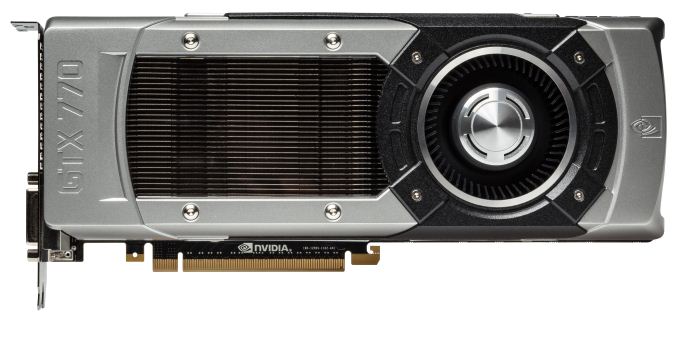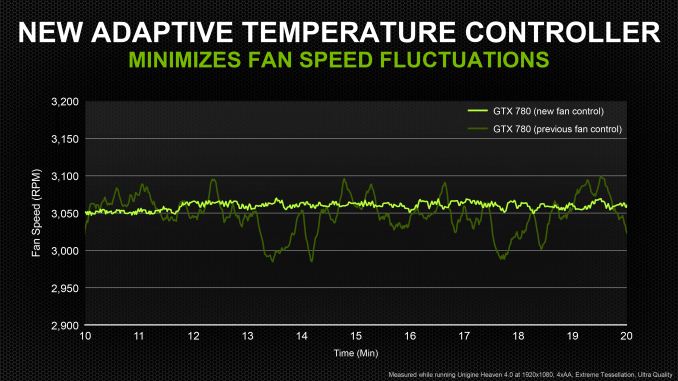NVIDIA GeForce GTX 770 Review: The $400 Fight
by Ryan Smith on May 30, 2013 9:00 AM ESTMeet The GeForce GTX 770
It’s unfortunate that none of NVIDIA’s North American partners will be selling cards based on NVIDIA’s reference design, since NVIDIA is once again using GTX Titan as their template for their design, making for a very high quality card. At the same time it’s unfortunate the reference design will not be available because it means that not everything we have to say about GTX 770 will be applicable to retail cards. We’re essentially reviewing a card with a unique cooler you can’t buy, which has been something of a recurring problem for us with these virtual launches.
In lieu of the reference design, NVIDIA’s partners will be going semi-custom right from the start. A lot of what we’re going to see are various 2 and 3 fan open air coolers, however at least a couple of partners will also be selling blowers, albeit plastic in place of the Titan-derived metal cooler. Still, blowers may be a bit hard to come by with GTX 670, which is something of an odd outcome given how prevalent blowers have been at this performance tier in the past.
In any case, we have a few different semi-custom GTX 770 cards that just arrived in-house (all of the overclocked variety) which we’ll be looking at next week. In the meantime let’s dive in to NVIDIA’s reference GTX 770.
Whereas GTX 780 was truly a Titan Mini, GTX 770 has a few more accommodations to account for the differences between the products, but the end product is still remarkably Titan-like. In short, GTX 770 is still a 10.5” long card composed of a cast aluminum housing, a nickel-tipped heatsink, an aluminum baseplate, and a vapor chamber providing heat transfer between the GPU and the heatsink. The end result is that NVIDIA maintains Titan’s excellent cooling performance while also maintaining Titan’s solid feel and eye-catching design.
The story is much the same on the PCB and component selection. The PCB itself is Titan’s PCB retrofitted for use with GK104 instead of GK110, which amounts to a handful of differences. Besides a new memory layout suitable for a 256bit bus operating at 7GHz, the other big change here is that NVIDIA has scaled down the power circuitry slightly, from a 6+2 phase design for their GK110 cards to a 5+1 phase design for GTX 770, in reflection of GTX 770’s lower 230W TDP.
On that note, for those of you looking for clean pictures of the PCB and GPU, unfortunately you will be out of luck as NVIDIA used the same silk-screened Shin-Etsu thermal compound as they did for GTX Titan. This compound is great for transferring heat and a great thing for GTX 770 buyers, but its composition and application means that we can’t take apart these cards without irrevocably damaging their cooling capabilities, and at the same time NVIDIA didn’t take pictures of their own.
Anyhow, with all of the similarities between GTX 770 and GTX 780/Titan, we are otherwise looking at a card that could be mistaken for Titan if not for the “GTX 770” stamped into the card’s shroud. This means that the I/O options are also identical, with a set of 8pin + 6pin power sockets providing the necessary extra power, a pair of SLI connectors allowing for up to 3-way SLI, and the NVIDIA standard display output configuration of 2x DL-DVI, 1x HDMI, 1x DisplayPort 1.2.
Like GTX 780, we expect to see some interesting designs come out of NVIDIA’s partners. The Titan cooler sets an extremely high bar here given the fact that it was designed for a higher 250W TDP, meaning it’s slightly overpowered for GTX 770. Meanwhile NVIDIA’s Greenlight approval program means that their partners semi-custom and custom designs need to maintain roughly the same level of quality, hence the common use of open-air coolers.
| GeForce Clockspeed Bins | ||||
| Clockspeed | GTX 770 | GTX 680 | ||
| 1149MHz | 1.212v | N/A | ||
| 1136MHz | 1.2v | N/A | ||
| 1123MHz | 1.187v | N/A | ||
| 1110MHz | 1.162v | 1.175v | ||
| 1097MHz | 1.15v | 1.15v | ||
| 1084MHz | 1.137v | 1.137v | ||
| 1071MHz | 1.125v | 1.125v | ||
| 1058MHz | 1.112v | 1.125v | ||
| 1045MHz | 1.1v | 1.112v | ||
Moving on to overclocking, as this is a GPU Boost 2.0 part, overclocking will also operate in the same way it did on GTX 780, and yes, this includes overvolting. GTX 770’s maximum power target is 106% (244W), and a very mild overvoltage of +0.012v is available, unlocking one higher boost bin. This also means that GTX 770 follows the usual TDP and temperature throttling conditions, with a standard temperature throttle of 80C. In practice (at least on our reference card) GTX 770 typically reaches its highest clockspeeds before it reaches the TDP or temperature throttles, so these are mostly of use in concert with overvolting and the use of offset clocks.
Finally, GTX 770 also includes the incremental fan speed improvements first introduced last week with GTX 780. So like GTX 780, GTX 770’s default fan controller programming is biased to react more slowly to temperature changes in order to minimize sudden shifts in fan speed.


















117 Comments
View All Comments
khanov - Friday, May 31, 2013 - link
*sigh*You failed again.
khanov - Friday, May 31, 2013 - link
Sorry dude, that wasn't aimed at you. Anand your comments system has a mind of its own.If I reply to xyz I sort of expect my reply to be below xyz's comment and not inserted randomly in to the comments list.
chizow - Thursday, May 30, 2013 - link
Once again, a year late, but still a nice card. The updated cooler and higher memory clocks are impressive, but the max Boost clock was achievable on "FTW" type binned GTX 680s in the past.I guess this is Nvidia's "Gigahertz Edition", basically an overclocked SKU to bring parity in the performance midrange market.
Homeles - Thursday, May 30, 2013 - link
How in the world is this card a year late? Nvidia was still winning at this time, one year ago. Now they have not one, not two, but three single GPU cards that are on parity or are faster than the 7970 GE. Nvidia is in a far better position than they were with their GTX 500 series.chizow - Thursday, May 30, 2013 - link
Full GK104 should've been GTX 670 and below from the outset, as Nvidia initially planned. That's why it's a year late, at this price point anyways.Also, AMD reached parity with Nvidia's GTX 680 last year with the 7970GE launch in June/July, which then distanced itself by 5-10% with the Never Settle Drivers in Sept/Oct last year.
Now that the GTX 770 has launched and is ~10% faster than the 680, it again, reaches parity with the 7970GE.
JPForums - Thursday, May 30, 2013 - link
I thought the 104/114 series was historically reserved for the x60, while the 100/110 series was meant for the x70/x80 chips. Thus this new highend GK104 model should have been a 760Ti. GK110 should have maxed out at the 780 and the 770 should have been the paired down model. If they really had to have a Titan, it should have been a DPFP uncapped 780 (so they got that almost right).Of course the prices should have been the usual highend price points and not the massive price jumps they are currently pushing. Sure you can justify the price with the current performance relative to the previous generation, but if we always did that, the high end cards would get perpetually more expensive as the performance of each new generation of cards would justify a price hike over the previous generation. In reality, these prices are the unfortunate result of a lack of competition. Of course not all companies handle lack of competition the same way. nVidia has shown that, when uncontested, they will jack introductory prices into the stratosphere (8800 Ultra - $800-1000, $650 - GTX280, Titan/GTX780 - $1000/$650). Under normal competitive conditions, the top single GPU card from either nVidia or AMD/ATi of each generation comes in at $500. In similarly uncontested situations AMD/ATi has proven to be much less abusive to their customers (7970 - $550, 5870 - $400). Granted the relatively low price of the Dual GPU GTX295 probably kept the 5870s price in check until the GTX400 series launched, but at that point there was a significant difference in stability between single and dual GPU cards. Now I must mention, lest anyone gets the wrong idea, that AMD/ATi was probably only taking this route because marketshare/mindshare was more important to them than profit margins. Nonetheless, the facts remain.
chizow - Thursday, May 30, 2013 - link
I agree with virtually everything you said, although I never really had a problem with Nvidia jumping GK104 up a SKU to the x70 range. The performance was certainly there especially relative to last-gen performance and full GK104 also beat AMD's best offering at the time.The problem I had was Nvidia's decision to turn this 2nd tier ASIC into their flagship and subsequently, hold off on launching their true flagship ASIC a full year AND charge $1000 (and later, $650) for it.
All events predicated on the fact AMD launched 7970 at flagship prices when it really didn't deserve the asking price. Tahiti launch set the stage for Nvidia to not only undercut AMD pricing but to beat them in performance as well with only their 2nd tier chip.
JPForums - Thursday, May 30, 2013 - link
True, the 7970 could definitely be considered overpriced when it launched, but it was the undisputed performance champ until nVidia finally launched the GTX680 to bring back competition. Though, this begs the question, was the 7970 really this underperforming, or was the GK104 simply larger and faster (relatively speaking) than midrange chips in the past. Given that the GK104 die size is smaller than the GTS250, GTX460, GTX555 die sizes, I'd say larger is out. That said, they removed a lot of compute resources to get the gaming performance they were targeting, so faster might hold some weight.The 7000 series sudden proficiency in compute combined with the equally sudden removal of compute focus in the GTX600 series meant the 7970 would need to be far larger to maintain equivalent performance. Given the fact that Tahiti XT (352mm) was much closer to the size of GK104 (294mm) than GK110 (561mm), the 7970 should probably be considered a mid-weight. That is to say I can conclude that Tahiti XT was under performing (in games) AND GK104 was an overachiever. So the question becomes, is compute capabilities important enough to sacrifice gaming performance that a year ago likely would have clocked in closer to the GTX780 (GTX775 class?) for compute performance that in many cases exceeds Titan, but gaming performance roughly on par with a GTX680?
JlHADJOE - Friday, May 31, 2013 - link
IMO AMD's initial, higher price on the 7970 was justified. People forget that it was a much bigger chip than the 6970, with a 384-bit bus instead of 256. Any 384-bit part is effectively big, IMO. Same size as the 580, and now the Titan and 780.The fault here IMO goes right back to AMD's marketing division. If they hadn't stupidly went from 5870 to 6970, then people might have noticed that Tahiti was in fact a bigger part than its two immediate predecessors, and properly deserving of the 7900-series naming.
EJS1980 - Thursday, May 30, 2013 - link
Pretty much this /I\I
I